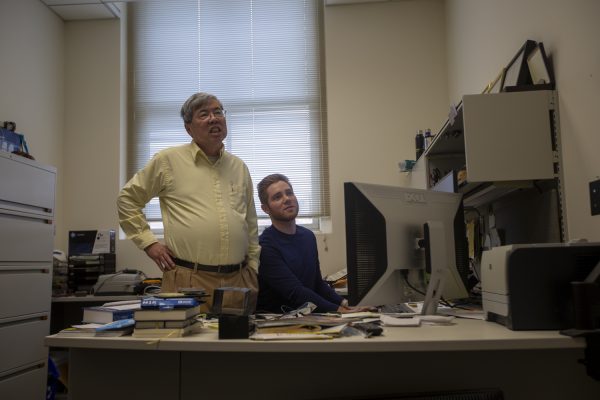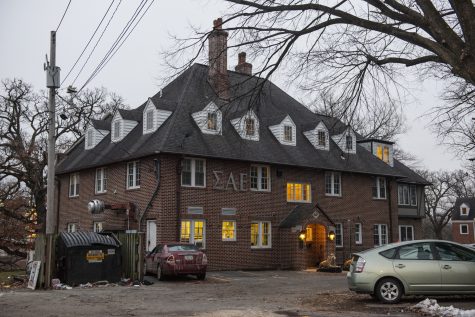Volunteers fight invasive garlic mustard
Garlic mustard, an invasive plant species, grows across campus and Iowa City. Volunteers pull the weed by hand in order to promote the growth of native species in green spaces on campus.
University of Iowa Arborist Andrew Dahl motions to a crop of garlic mustard weeds in the wooded area outside the Boyd Law Library on Wednesday, April 24, 2019.
Across campus areas and parks in Iowa City, community members are making a difference by pulling weeds.
Garlic mustard, an invasive species originally from Eurasia, grows in several areas on the University of Iowa campus, including near the Boyd Law Building and Hancher.
The most effective way to eliminate garlic mustard is to pull the plant out of the ground by hand. Students and community members participate in “garlic mustard pulls” to clear out the plants from wooded areas on campus a few times a week during the spring semester.
UI arborist Andrew Dahl said garlic mustard is so difficult to get rid of because it does not have any natural predators.
“Each plant can have up to 25,000 seeds. That’s a lot of seeds to come up, and it will basically take over an area,” he said. “It doesn’t have a natural checks or balances here. There’s no species that eats it, there’s no disease, so there’s nothing to hold back to population in that respect.”

University of Iowa arborist Andrew Dahl speaks with a reporter about mustard-weed pulls outside the Boyd Law Library on April 24.
The plant, when left alone, will multiply quickly and take up large patches of land.
“Garlic mustard is also allopathic, which means that it exudes a chemical from the roots that can inhibit germination of other plants nearby,” Dahl said. “It’ll form these colonies of nothing but garlic mustard and push out the [flora], and it can even inhibit tree germination. It’ll just be a carpet.”
RELATED: UI greenhouse provides students and community members a place for plant interests
Dahl said garlic mustard has been pulled at the Boyd Law Building for the last 17 years.
“Last year, it was kind of hard to find any. We’re making strides as far as reducing the population — but I don’t think we’ll eliminate it,” he said. “We hand-pull it. You can spray herbicide on it, but you’re liable to kill the very plants that you’re wanting to save from garlic mustard.”
UI environmental-science student Hannah Burgener has spent the past two summers interning in Michigan with the Midwest Invasive Species Information Network, developing educational programs and guiding volunteers on how to remove garlic mustard and other invasive species.
She said garlic mustard is an easy plant to educate volunteers about.
“It’s pretty easily identifiable plant with its mustard shaped weeds and white flowers. It’s an easy one for volunteers to go out and pull; it doesn’t require a lot of identification,” she said. “Garlic mustard is one of those plants that will grow in any sort of human-disturbed environment. I’ve seen it grow on tree stumps, the ground, cracks in the road.”
Dahl said garlic mustard spreads easily with both humans and deer tracking garlic mustard seeds through the area.

A garlic mustard weed is shown outside the Boyd Law Library on April 24.
Hickory Hill Park is another site in which garlic mustard has frequently been found. UI student Jackson Allmon has volunteered at pulls on the UI campus and at Hickory Hill.
“I’ve learned that garlic mustard — there’s a lot more growing, and there’s a lot more out there than we think there is. We’ve been picking for hours on end, and we’ve barely made a dent,” he said. “We need help from all the students in the university to get out there and have some impact pulling some garlic mustard themselves, because even though all these students are coming out here, there’s so much more.”

(she/her/hers)
Rylee Wilson is a Managing Editor at The Daily Iowan. She has previously worked as a news editor, news reporter, and politics reporter...

(he/him/his)
Email: [email protected]
Ryan Adams is the Films Assistant Visuals Editor at The Daily Iowan. He is a senior at the University of Iowa...















